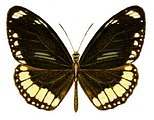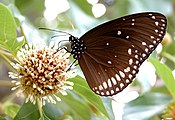Euploea sylvester
| Double-branded crow | |
|---|---|

| |
| Scientific classification | |
| Domain: | Eukaryota |
| Kingdom: | Animalia |
| Phylum: | Arthropoda |
| Class: | Insecta |
| Order: | Lepidoptera |
| Family: | Nymphalidae |
| Genus: | Euploea |
| Species: | E. sylvester
|
| Binomial name | |
| Euploea sylvester (Fabricius, 1793)
| |
| Synonyms | |
Euploea sylvester, the double-branded crow,[2] also known as the two-brand crow[1] in Australia, is a butterfly found in South Asia,[2] Southeast Asia and parts of Australia that belongs to the crows and tigers, that is, the danaid group of the brush-footed butterflies family.[1]
Several races of the butterfly are recognized. Race pelor is found in Australia.[3]
Subspecies
The subspecies of Euploea sylvester are-[1][2]
- E. s. sylvester - Cape York - Rockhampton, Torres Strait Is.
- E. s. coreta (Godart, 1819) - Sri Lanka, S.India
- E. s. hopei (Felder & Felder, 1865) - Sikkim - Burma, Assam, Indo-China, Peninsular Malaya
- E. s. pelor Doubleday, 1847 - NW.Australia, Northern Territory
Description

In shape, colour, and markings, it very closely resembles Euploea core. Males, however, can be distinguished at once by the presence of two brands instead of a single one on the forewing. Of the females Lionel de Nicéville says, females of E. coreta can be separated from the females of E. core by the following points: "First by the outline of the forewing being more entire; in core it is slightly but perceptibly scalloped- Second, by the underside of the forewing having a complete series of six spots, one between each pair of nervules outside the cell; in core two of these spots, those above the discoidal nervules (veins 5 and 6), are always wanting. Third, the two brands on the interno-median area (interspace 1) of the forewing in the male are faintly but quite perceptibly to be traced in the female in the same position."[4][5]
Larval food plants
The double-banded crow feeds on plants of the families Apocynaceae (dogbanes and oleanders), Asclepiadaceae (milkweeds) and Moraceae (figs) and the specific species are Ficus obliqua, Ficus microcarpa, Ficus racemosa, Gymnema sylvestre and Ichnocarpus frutescens [6]
Gallery
-
Euploea sylvester pelor In Australia
-
Euploea sylvester hopei In Buxa Tiger Reserve, West Bengal, India
-
Euploea sylvester coreta In Bangalore, Karnataka, India
See also
References
- ^ a b c d e Savela, Markku. "Euploea sylvester (Fabricius, 1793)". Lepidoptera and Some Other Life Forms. Retrieved July 1, 2018.
- ^ a b c Varshney, R.K.; Smetacek, Peter (2015). A Synoptic Catalogue of the Butterflies of India. New Delhi: Butterfly Research Centre, Bhimtal & Indinov Publishing, New Delhi. p. 152. doi:10.13140/RG.2.1.3966.2164. ISBN 978-81-929826-4-9.
- ^ Meyer, C.E. (1997) Notes on the life history and variation in adult forms of Euploea sylvester pelor Doubleday (Lepidoptera: Nymphalidae: Danainae), The Australian Entomologist. 24(2):73-77.
- ^
 This article incorporates text from this source, which is in the public domain: Bingham, Charles Thomas (1907). Fauna of British India. Butterflies Vol. 2. Taylor & Francis. pp. 29–11.
This article incorporates text from this source, which is in the public domain: Bingham, Charles Thomas (1907). Fauna of British India. Butterflies Vol. 2. Taylor & Francis. pp. 29–11.
- ^
 This article incorporates text from this source, which is in the public domain: Moore, Frederic (1890–1892). Lepidoptera Indica. Vol. I. London: Lovell Reeve and Co. p. 134.
This article incorporates text from this source, which is in the public domain: Moore, Frederic (1890–1892). Lepidoptera Indica. Vol. I. London: Lovell Reeve and Co. p. 134.{{cite book}}: CS1 maint: date format (link) - ^ HOSTS - a Database of the World's Lepidopteran Hostplants (http://www.nhm.ac.uk/research-curation/projects/hostplants/) accessed on September 12, 2007.



